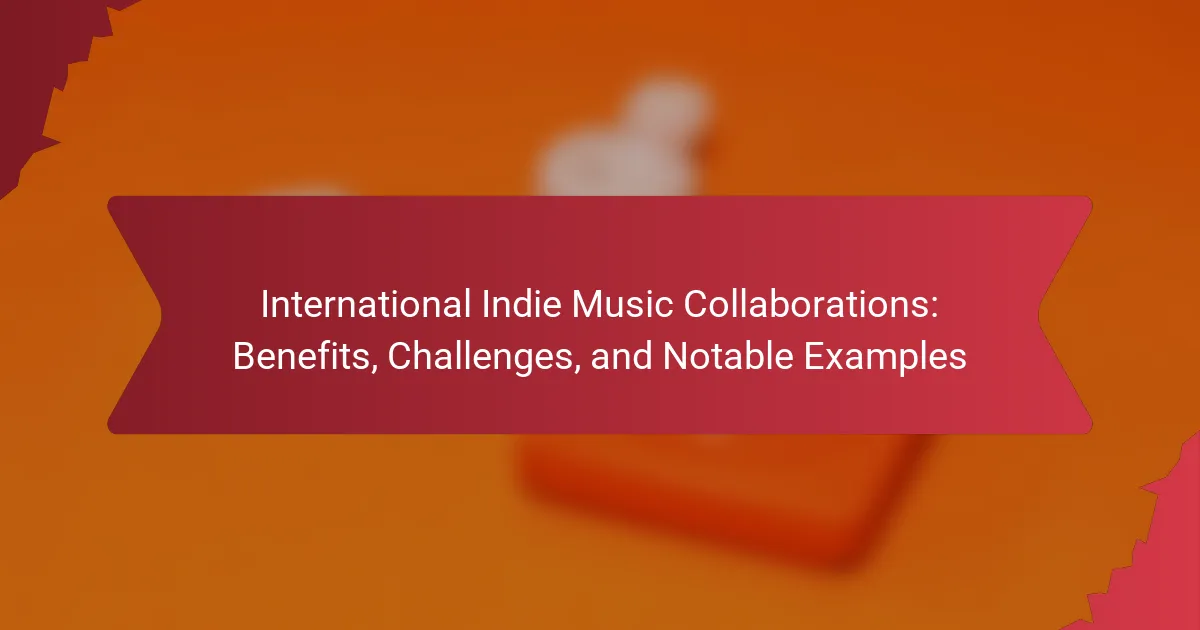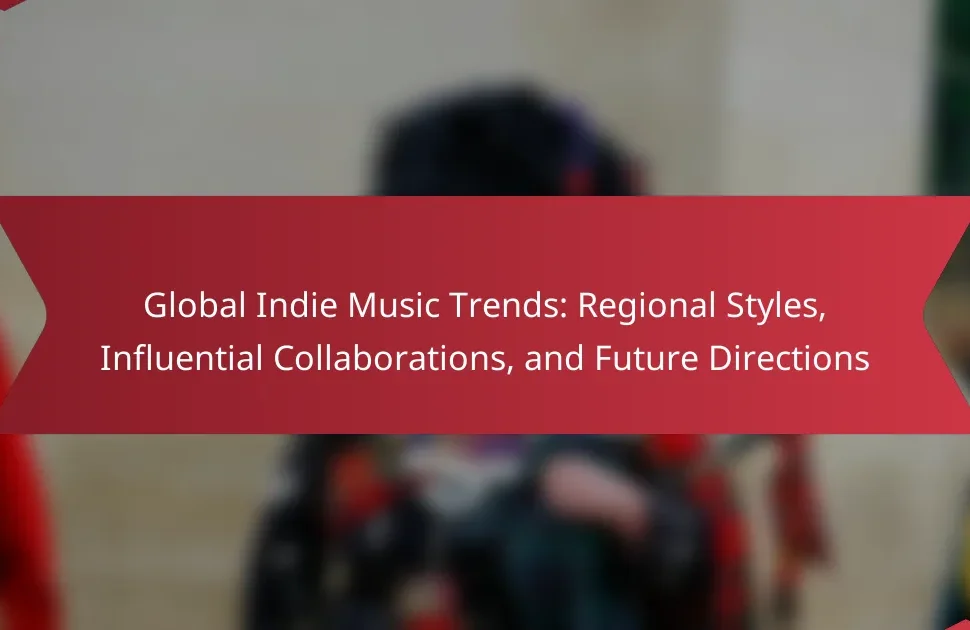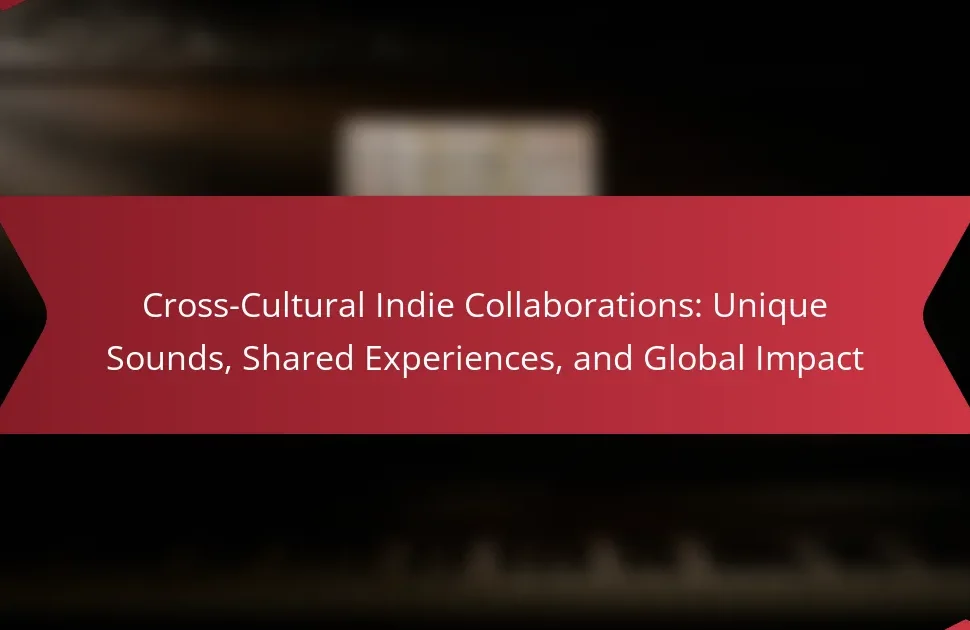International indie music collaborations enhance creativity, expand audience reach, and foster cultural exchange. However, artists face challenges such as communication barriers and logistical issues. Notable examples illustrate the impact of these partnerships on the genre. Successful collaborations rely on mutual respect, diverse perspectives, and clear communication.

What are the key benefits of international indie music collaborations?
International indie music collaborations offer diverse benefits, including cultural exchange, expanded audience reach, and enhanced creativity. These collaborations allow artists to blend unique styles, leading to innovative sounds. Additionally, they foster networking opportunities, facilitating future projects and career growth. Collaborations can also increase visibility in global markets, attracting new listeners and fans.
How do cultural exchanges enhance musical creativity?
Cultural exchanges enhance musical creativity by fostering collaboration and innovation among diverse artists. They enable musicians to blend different styles, techniques, and perspectives, resulting in unique soundscapes.
International indie music collaborations often lead to the fusion of genres, creating fresh musical expressions. For example, a collaboration between artists from different cultural backgrounds can introduce instruments or rhythms unfamiliar to one another, enriching the creative process.
Additionally, these exchanges can inspire new lyrical themes and storytelling approaches. Exposure to varied cultural narratives allows artists to explore different emotional depths and social issues, broadening their artistic horizons.
Notable examples include collaborations that have produced award-winning tracks, showcasing the powerful impact of cultural synergy in music creation.
What economic advantages can arise from cross-border collaborations?
Cross-border collaborations in indie music can yield significant economic advantages. They enhance market access by allowing artists to reach diverse audiences, increasing revenue potential. Collaborations often lead to shared resources, reducing production costs. Additionally, they foster innovation through cultural exchange, which can result in unique musical products that attract attention. This synergy can also stimulate local economies, particularly in regions that host collaborative events or festivals.
How do international collaborations expand audience reach?
International collaborations significantly expand audience reach by tapping into diverse markets and cultural exchanges. Collaborating artists can leverage each other’s fan bases, resulting in increased visibility and engagement. For instance, a partnership between artists from different countries can introduce unique sounds and styles, attracting listeners who appreciate cross-cultural influences. This synergy often leads to innovative music that resonates with a broader audience, enhancing global appeal. Notable examples include collaborations like Major Lazer’s work with artists from various countries, which have successfully penetrated international charts.
Which platforms facilitate global indie music partnerships?
Platforms that facilitate global indie music partnerships include Bandcamp, SoundCloud, DistroKid, and Splice. These platforms enable artists to collaborate, distribute music, and connect with audiences worldwide. Bandcamp allows direct sales and fan engagement, while SoundCloud offers a vast community for sharing and discovering new music. DistroKid simplifies distribution across various streaming services, and Splice provides tools for collaboration and music production. Each platform has unique features that support indie artists in building international partnerships.
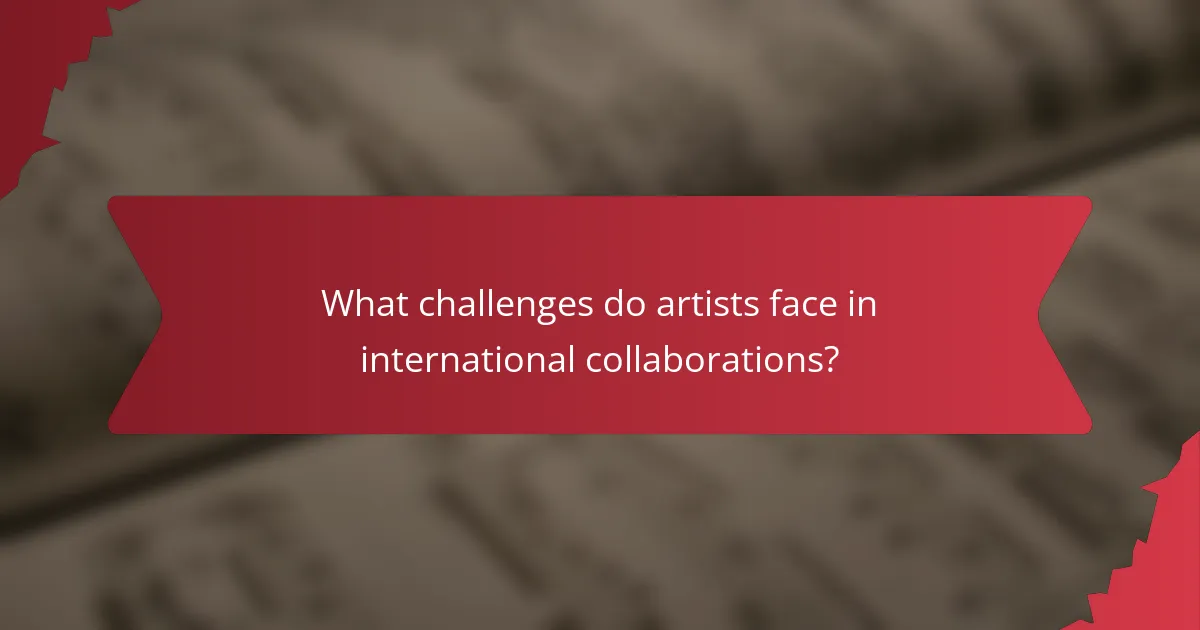
What challenges do artists face in international collaborations?
Artists face numerous challenges in international collaborations, including cultural differences, communication barriers, and logistical issues. These factors can complicate the creative process and hinder project success. Cultural misunderstandings may lead to conflicts over artistic vision, while language barriers can impede effective collaboration. Logistical challenges, such as differing time zones and travel restrictions, can also disrupt workflow. Additionally, navigating legal and financial aspects across countries adds complexity to these collaborations.
How do language barriers impact collaboration efforts?
Language barriers significantly hinder collaboration efforts in international indie music projects. They can lead to miscommunication, misunderstandings, and reduced creativity. Musicians may struggle to convey their artistic vision or collaborate effectively on lyrics and melodies. As a result, the collaborative process may take longer and lack cohesion. Bridging these barriers through translation services or bilingual team members can enhance collaboration and foster a more inclusive artistic environment.
What legal and copyright issues arise in cross-border music projects?
Legal and copyright issues in cross-border music projects include varying copyright laws, licensing complexities, and potential infringement disputes. Artists must navigate different jurisdictions, which can complicate ownership rights and revenue sharing. Understanding these legal frameworks is essential for successful collaborations.
How do differing musical styles create challenges in collaboration?
Differing musical styles create collaboration challenges through contrasting creative processes and communication barriers. Musicians from diverse backgrounds may have unique approaches to rhythm, melody, and structure. These differences can lead to misunderstandings and difficulties in achieving a cohesive sound. Additionally, varying cultural contexts can influence how artists perceive and interpret musical elements, complicating joint efforts. Embracing these challenges can foster innovation and result in distinctive, hybrid musical forms.

Which notable international indie music collaborations have made an impact?
Notable international indie music collaborations have significantly impacted the genre, enhancing creativity and broadening audiences. Examples include “The Lonely Island” collaborating with artists like Akon and T-Pain, which blended comedy and music for viral success. Another impactful collaboration is “Bon Iver” and “James Blake,” merging indie folk with electronic elements, creating a unique sound that influenced many artists. Additionally, “ODESZA” has worked with various international musicians, showcasing diverse influences and expanding their reach. These collaborations highlight the benefits of cross-cultural exchange in indie music.
What are some successful examples from the European indie scene?
Notable examples from the European indie scene include collaborations like the joint project between the British band Alt-J and the German artist AnnenMayKantereit. This partnership showcased the blending of distinct musical styles, resulting in a unique sound that captivated audiences across borders. Another successful instance is the collaboration of the French artist Christine and the Queens with various artists from different countries, highlighting the cross-cultural exchange within the indie genre. These collaborations not only enhance artistic diversity but also expand reach in international markets.
How have Asian artists contributed to global indie music collaborations?
Asian artists have significantly enriched global indie music collaborations by introducing diverse sounds and cultural influences. Their unique perspectives and innovative approaches have led to groundbreaking projects that resonate worldwide.
Collaborations often highlight the fusion of traditional Asian instruments with contemporary indie styles, creating fresh musical experiences. For example, artists like Mitski and Yaeji have successfully merged their cultural backgrounds with global indie trends, enhancing the genre’s appeal.
Challenges include navigating language barriers and differing artistic expectations. However, these obstacles often lead to creative solutions, fostering deeper connections among artists. The result is a vibrant, collaborative ecosystem that continues to evolve.
Notable examples include the partnership between Japanese band Mono and various international musicians, showcasing the power of cross-cultural collaboration. Such efforts underline the importance of Asian artists in shaping the future of indie music on a global scale.
What role do festivals play in promoting international indie collaborations?
Festivals significantly enhance international indie music collaborations by providing platforms for artists to connect. They foster networking opportunities, enabling musicians from diverse backgrounds to share ideas and create unique sounds. Festivals often showcase a variety of genres, attracting a global audience and encouraging cultural exchange. Notable examples include the South by Southwest (SXSW) festival, which has launched many successful collaborations. Additionally, festivals can facilitate access to industry professionals, increasing visibility for indie artists and enhancing their chances of successful partnerships.
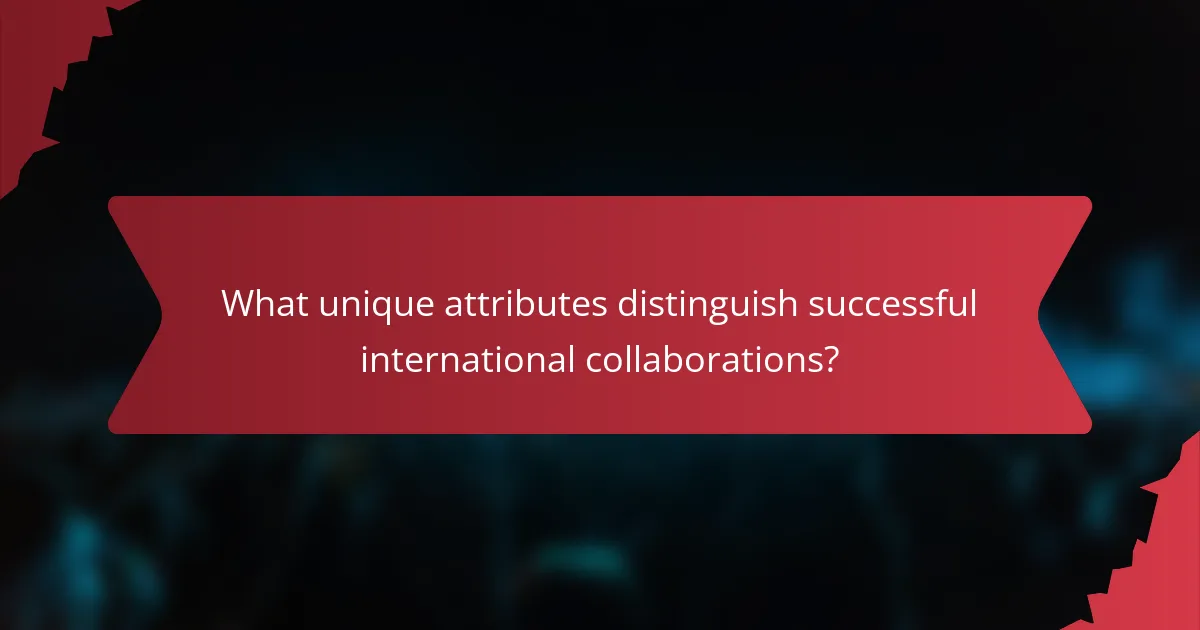
What unique attributes distinguish successful international collaborations?
Successful international collaborations are distinguished by cultural exchange, diverse perspectives, mutual respect, and shared goals. Cultural exchange enhances creativity and innovation, while diverse perspectives bring unique ideas. Mutual respect fosters trust, and shared goals align efforts for success. Notable examples include collaborations like “Despacito,” which united artists across borders, showcasing the power of music to transcend cultural barriers. These attributes create a strong foundation for impactful partnerships in the indie music scene.
How does the blending of diverse musical genres create unique soundscapes?
The blending of diverse musical genres creates unique soundscapes by fostering innovation and cross-cultural collaboration. This fusion enriches the music, allowing artists to explore new rhythms, melodies, and lyrical themes. Notable examples include collaborations like the fusion of Afrobeat and rock, which results in fresh, vibrant sounds. These partnerships often face challenges, such as cultural misunderstandings, but the benefits, including broader audience reach and creative growth, outweigh the obstacles.
What innovative marketing strategies are used in international indie collaborations?
Innovative marketing strategies in international indie collaborations often leverage social media, cross-promotion, and unique content creation. These strategies enhance visibility and engagement across diverse audiences. Collaborations can utilize platforms like Instagram and TikTok for viral challenges or behind-the-scenes content, fostering community interaction. Additionally, storytelling through shared experiences and cultural exchange can deepen audience connection. Notable examples include collaborative music videos that blend different artistic styles, showcasing the unique attributes of each artist while appealing to their respective fan bases.
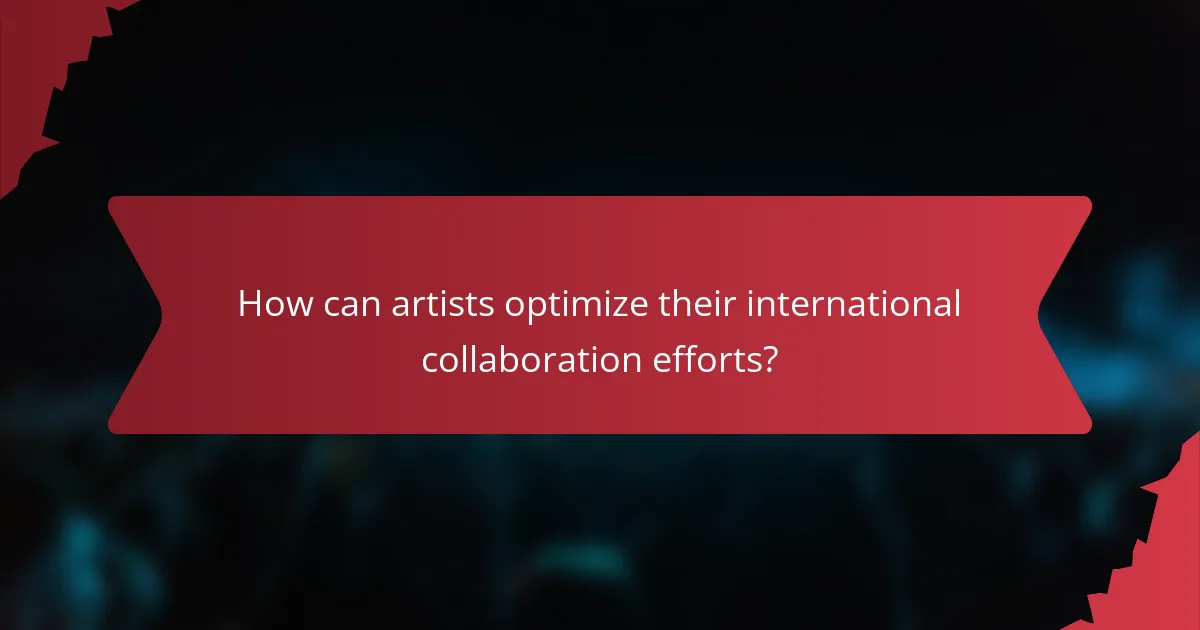
How can artists optimize their international collaboration efforts?
Artists can optimize their international collaboration efforts by leveraging technology, building diverse networks, and understanding cultural nuances. Utilizing platforms like social media and music collaboration tools enhances connectivity and idea sharing. Engaging with local artists fosters authenticity and expands creative horizons. Additionally, being mindful of cultural differences can prevent misunderstandings and enrich the collaborative process. Establishing clear communication and setting mutual goals further strengthens partnerships.
What best practices should artists follow for successful cross-border projects?
Artists should prioritize clear communication, cultural sensitivity, and mutual respect in cross-border projects. Establishing a shared vision and setting realistic timelines enhances collaboration. Regular feedback loops ensure alignment and address challenges promptly. Understanding legal and financial implications is crucial for successful partnerships.
Which common mistakes should be avoided in international collaborations?
To avoid common mistakes in international indie music collaborations, focus on clear communication, cultural sensitivity, and defined roles. Misunderstandings can arise from language barriers, so ensure all parties understand project goals. Respect cultural differences to foster creativity and collaboration. Clearly outline responsibilities to prevent conflicts and ensure smooth workflow.
